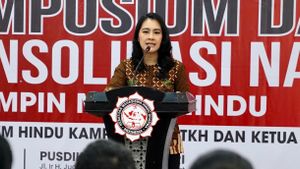JAKARTA - At least two judges of the Constitutional Court (MK) namely Suhartoyo and Daniel Yusmic P. Foekh are concurring opinions or have different reasons regarding rejecting the lawsuit against Law Number 1 of 1974 concerning marriage points of different religions.
"Against the decision of the Constitutional Court a quo, two judges, namely judge Suhartoyo and judge Daniel Yusmic P. Foekh, have different reasons," said Chief Justice of the Constitutional Court Anwar Usman in Jakarta, Tuesday, January 31, as reported by Antara.
On that occasion, Judge Suhartoyo conveyed a different additional reason.
First, he continued, the legal basis for the legal stipulation of marriage and freedom or independence to embrace and worship according to their respective religions is regulated in the following norms.
Article 1 of Law Number 1 of 1974 is a "internal bond between a man and a woman as husband and wife with the aim of forming a happy and lasting family (household) based on One Supreme God".
Next, Article 2 Paragraph (1) of Law Number 1 Year 1974 which reads that each marriage is recorded according to the law of each religion and its belief. Then Paragraph (2) reads that each marriage is recorded according to the applicable laws and regulations.
Furthermore, Judge Suhartoyo said referring to Article 29 Paragraph (1) of the 1945 Constitution it was stated, "The state is based on God Almighty" indicating that Indonesia is not a country that adheres to secularism.
Article 29 Paragraph (2) of the 1945 Constitution states, "The state guarantees the independence of each resident to embrace their respective religions, and to worship according to their religion and beliefs".
"The three legal foundations are a concrete form of the state in interpreting the nature of marriage and also the state in guaranteeing the freedom of society in choosing and carrying out their respective religions and beliefs," he said.
He said the legal basis was philosophically built because it was undeniable that Indonesia was a plural country that had a diversity of ethnicity, culture, race, religion and belief.
Regarding the norms tested in the a quo case, the existence of religious norms and legal norms in the same regulation has the potential to weaken each other, even their actual and potential behavior.
In line with that, judge Daniel Yusmic P. Foekh believes that the issue of marriage of different religions is a problem that actually exists and should be suspected to continue until now and in the future.
At least, he continued, there are several patterns that citizens do to carry out marriages of different religions.
First, he continued, to have marriage abroad, one of the brides and groom from a couple who intends to have a different religion marriage temporarily convert to follow their partner's religion.
Third, get married twice where the first marriage, for example, follows the religion of her future husband and after that remarry (second marriage) according to the religion of his wife or vice versa.
"The three patterns on the one hand are considered to be a form of smuggling the law against marriages of different religions, but on the other hand it is a step of 'teroboration' by the pair of prospective marriages of different religions due to the absence of law on marriages of different religions," he said.
The English, Chinese, Japanese, Arabic, and French versions are automatically generated by the AI. So there may still be inaccuracies in translating, please always see Indonesian as our main language. (system supported by DigitalSiber.id)













